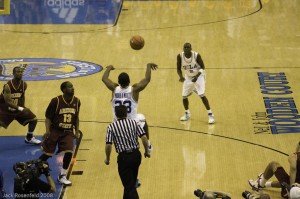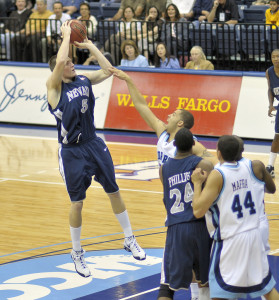Jump Stop vs. Stride Stop
The Jump Stop and Stride Stop are two of the more fundamental techniques every player in basketball will need to master in order to develop their game at any level. While both techniques do a similar job, they do have different uses and have an effect on the outcome of a situation through the use of one over the other. Being aware of the differences between a Jump Stop and Stride Stop is the first step in a coach being able to instruct and develop their player in the finer teaching points of these two core techniques.

The Jump Stop is one of the first fundamental skills that will be taught to players of all age groups and abilities. The Jump Stop is performed with a player jumping and landing on two feet, shoulder width apart. The Jump Stop is used by player to stop dribbling and pick the ball up or upon receiving a pass using this technique allows a player to catch a ball and then pivot on any foot.
The Stride Stop is identified when a player stops on one foot first before taking another step with the opposite foot and finally finishing with both feet in contact with the floor. Because one foot makes contact with the floor when picking the ball up from a dribble or catch first, this foot must be the pivot foot for the player. This means the player can still rotate as needed, but must do so with the original foot as the pivot foot.
Benefits of the Jump-Stop
The traditional Jump Stop has a number of benefits. The first is that for children because two feet make contact with the floor at the same time the balance of the player is benefited. This is especially important for young players as they learn to develop through the sport of basketball their ability to control their body. The Jump Stop is often the first type of stop taught to developing players as it a little easier to use and control.
The Jump Stop also has the added benefit as stated earlier, of allowing player to pivot on either foot. This is really a significant technical and in some cases tactical advantage. For example if a player is about to engage in an on-ball screening situation it is very advantageous to just a jump stop when receiving a pass so the offensive player can look to attack in either direction off of the on-ball screen.
Another situation that demands the use of the Jump Stop is during rebounding situations. It is especially advantageous for rebounders to land with both feet at the same time (Jump Stop) so they again can pivot in either direction to make the outlet pass and start a team’s fast break or primary transition phase on offense.
Benefits of the Stride Stop
The Stride Stop is a fantastic skill for players as they develop their competence to play with some additional speed and still remain in control of their balance and body positioning. By allowing one foot to make contact before the other the Stride Stop mirrors the running action of a player. This allows for the player to use the Stride Stop more succinctly at pace to pull-up or perform what task they are linking with the Stride Stop.

Because the Stride Stop does mirror the running action of a player it is also more useful in maintaining a players momentum when performing activities like passing. This means a Stride Stop is often used in conjunction with phases of the game like fast breaks, primary and secondary transition.
Improving the Speed of Your Shot with a Stride Stop
One of the most significant benefits of using the Stride Stop is that it can be linked into a player’s jump shot to provide a quicker shooting action. Again, because the Stride Stop mimics a players normal running style which helps maintain speed and momentum using a Stride Stop instead of a Jump Stops will help to have a player jumping into their shot sooner than the traditional Jump Stop.
Coaches should be looking to integrate the Stride Stop into their player’s one dribble and two dribble jump-shot as soon as their physiological development allows. The sooner a player can learn to use the Stride Stop, the sooner they can start to learn how to control the additional speed and power generated from this technique.
Both the Jump Stop and Stride Stop are mandatory fundamental skills that all players should be introduced to. Both have their place in different situations in a game of basketball.








Stride stop is definitely faster for getting a shot out off a dribble. However, isn’t it better to get a shot out fast further away from defenders with a jump stop off a dribble?
Hi Coach, this is all about context and the situation a ball handler finds themselves in. Where the offensive player has limited space and is shortening the distance between themselves and the defender a stride stop is usually most beneficial. Where the offensive player is moving away from the defender then a jump stop can be employed without any negative effects.